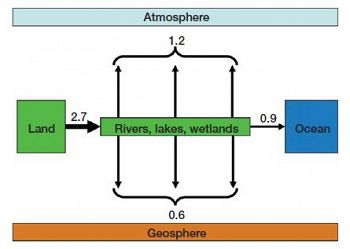Aufdenkampe et al., 2011
Riverine coupling of biogeochemical cycles between land, oceans, and atmosphere.
Aufdenkampe, A. K., Mayorga, E., Raymond, P. A., Melack, J. M., Doney, S. C., Alin, S. R., Aalto, R. E., and Yoo, K. (2011)
Frontiers in Ecology and the Environment 9:53-60.
-
Christina, INVESTIGATOR
-
National, INVESTIGATOR, STAFF
-
Christina, INVESTIGATOR
-
Christina, INVESTIGATOR
Abstract
The coupling of land, oceans, and atmosphere by rivers, lakes, and wetlands. All numbers are fluxes in units of Pg C yr−1, with values based on an analysis by Battin et al. (2009); accumulation fluxes within both land and ocean each equal 2.2 Pg C yr–1.
Streams, rivers, lakes, and other inland waters are important agents in the coupling of biogeochemical cycles between continents, atmosphere, and oceans. The depiction of these roles in global-scale assessments of carbon (C) and other bioactive elements remains limited, yet recent findings suggest that C discharged to the oceans is only a fraction of that entering rivers from terrestrial ecosystems via soil respiration, leaching, chemical weathering, and physical erosion. Most of this C influx is returned to the atmosphere from inland waters as carbon dioxide (CO2) or buried in sedimentary deposits within impoundments, lakes, floodplains, and other wetlands. Carbon and mineral cycles are coupled by both erosion–deposition processes and chemical weathering, with the latter producing dissolved inorganic C and carbonate buffering capacity that strongly modulate downstream pH, biological production of calcium-carbonate shells, and CO2 outgassing in rivers, estuaries, and coastal zones. Human activities substantially affect all of these processes.
Citation
Aufdenkampe, A. K., Mayorga, E., Raymond, P. A., Melack, J. M., Doney, S. C., Alin, S. R., Aalto, R. E., and Yoo, K. (2011): Riverine coupling of biogeochemical cycles between land, oceans, and atmosphere. Frontiers in Ecology and the Environment 9:53-60.. DOI: 10.1890/100014
 This Paper/Book acknowledges NSF CZO grant support.
This Paper/Book acknowledges NSF CZO grant support.
Explore Further





